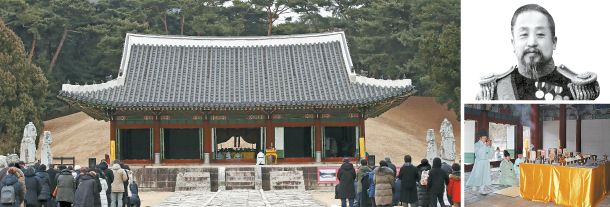Remembering the death that started a movement: Emperor Gojong’s controversial passing began a year of change
Published: 22 Jan. 2019, 18:27

Left: People gather to witness the grand ancestral rite to commemorate the 100th anniversary of Emperor Gojong’s, above right, death on Jan. 21, 1919. The ancestral rite, known as jesa, was held on Monday at Hongneung in Namyangju, Gyeonggi, where Emperor Gojong and Empress Myeongseong are buried. [YONHAP]
The controversial death of the emperor is said to have triggered the March 1st Independence Movement, which impacted the establishment of the provisional government of the Republic of Korea the following month.
“Because Emperor Gojong was a pivotal figure in Korea’s independence movement at the time, he was an eyesore to the Japanese imperialists and pro-Japanese traitors,” said Lee Won, director of the Dae Han Imperial House, explaining why Gojong’s death gave rise to the March 1st Independence Movement.
To commemorate the emperor’s death, the country holds a grand jesa, or ancestral rite, every year at Gojong and his wife Empress Myeongseong’s (1851-95) burial ground known as Hongneung in Namyangju, Gyeonggi. This year’s rite, held on Monday, was especially large as it reenacted the entire funeral process that happened a century ago. To mark the 100th anniversary, there will also be a special photo exhibition near the tomb until Thursday, shedding light on the history of the Korean Empire (1897-1910).
Meanwhile, a number of research projects regarding the independent movement, activists and the beginning of the Republic of Korea are gathering momentum thanks to this year’s centenary events.
Recent findings include a report on the condition of independence activist Yu Gwan-sun’s family written by a Japanese official who was the governor of South Chungcheong. It was submitted to the Japanese Government General of Korea.
“Yu Gwan-sun’s family in Cheonan County is facing a miserable plight and in a state of distress after being disposed for sedition and violating the security law,” states the report written on July 9, 1919.
Kim found this historical document in the Korean history database of the National Institute of Korean History and published it in last year’s December edition of the Academy of Korean Studies academic journal.
Kim insists that “this report proves that the Japanese government in Korea watched over Yu’s family with concern that the death of Yu and her parents as well as the imprisonment of her brother may influence public sentiment.”
Numerous historical records have also been discovered in recent years including a letter written by independence activist Lyuh Woon-hyung in 1918 addressed to then-U.S. President Woodrow Wilson, a written petition that was taken by activist Kim Kyu-sik to the Paris Peace Conference in January 1919, as well as articles by major French newspapers on Kim’s speech.
Experts still believe that there will be more historical documents regarding the March 1st Independence Movement and the establishment of the Korean government revealed throughout the year.
BY YIM SEUNG-HYE [sharon@joongang.co.kr]










with the Korea JoongAng Daily
To write comments, please log in to one of the accounts.
Standards Board Policy (0/250자)